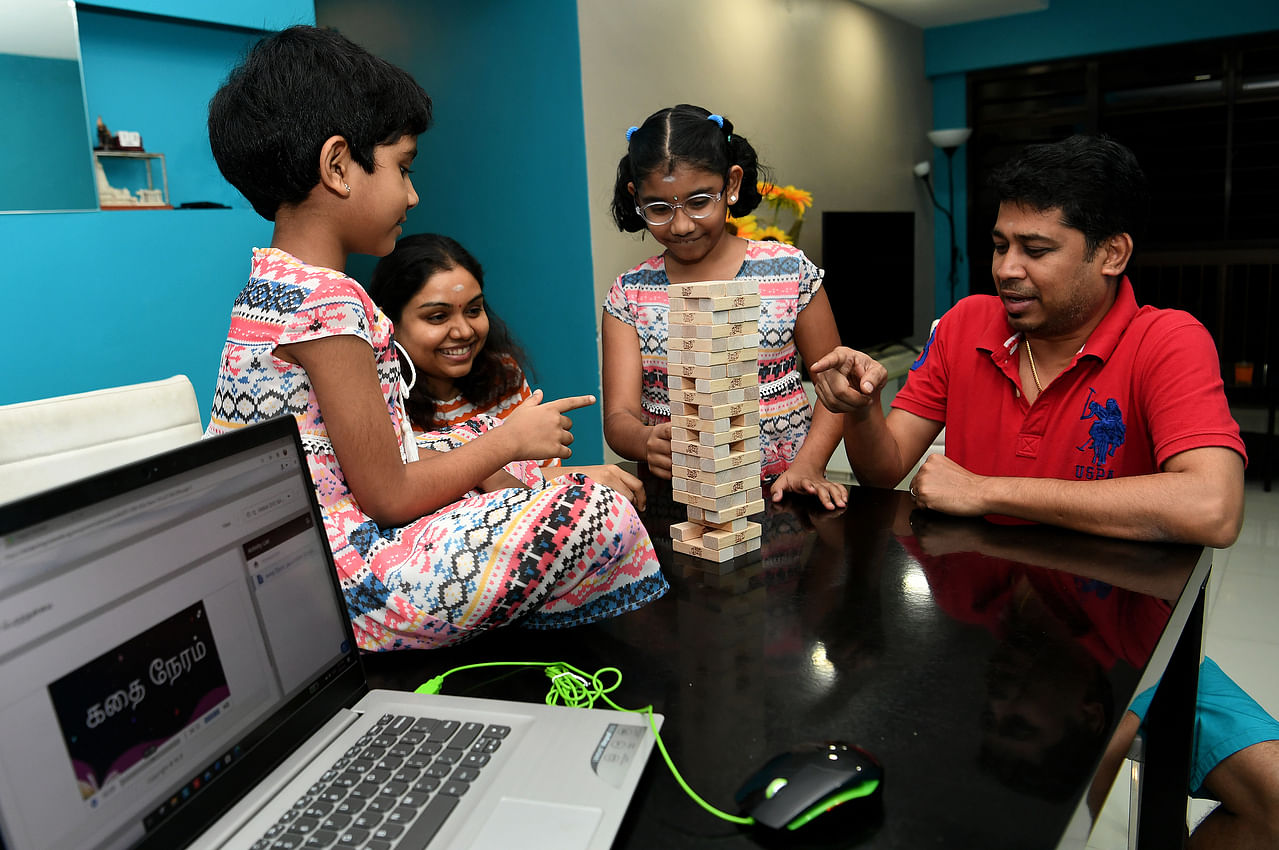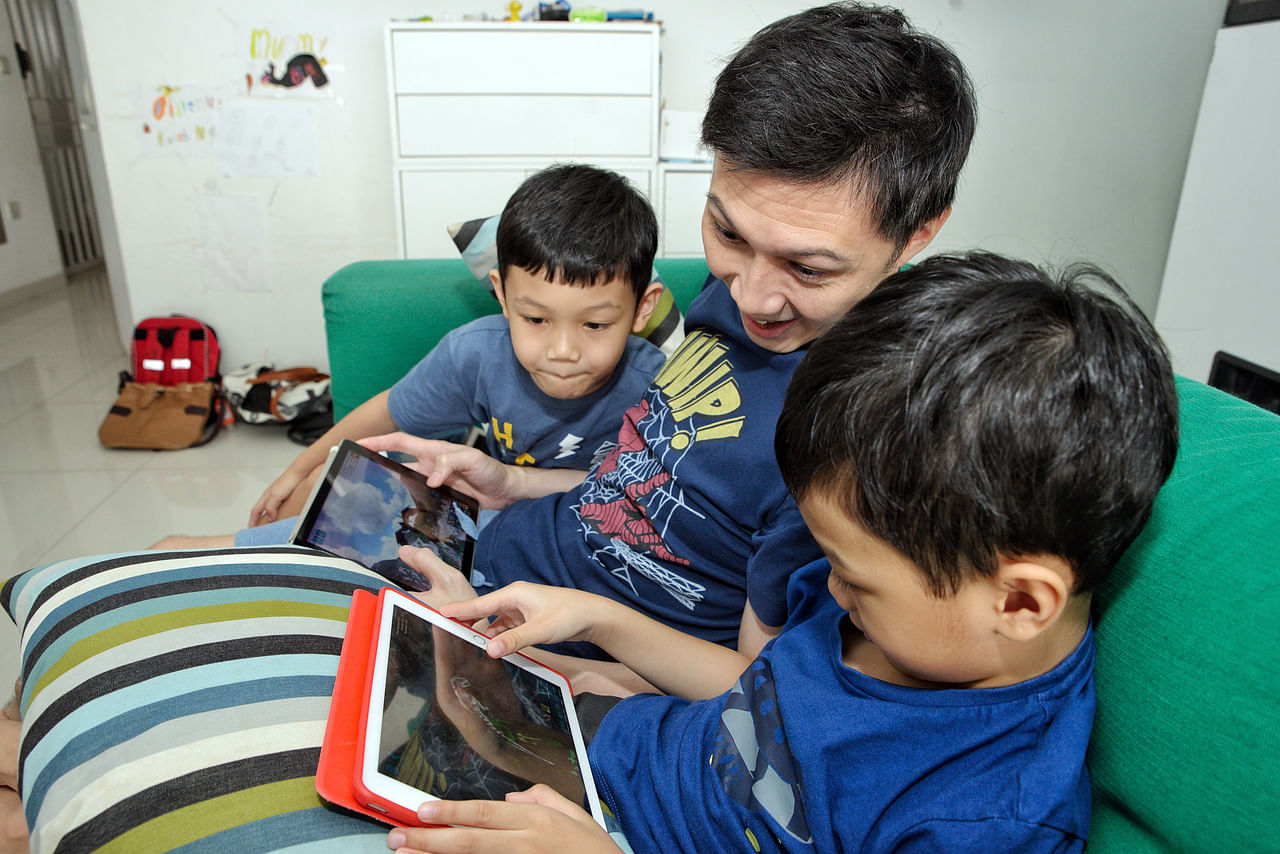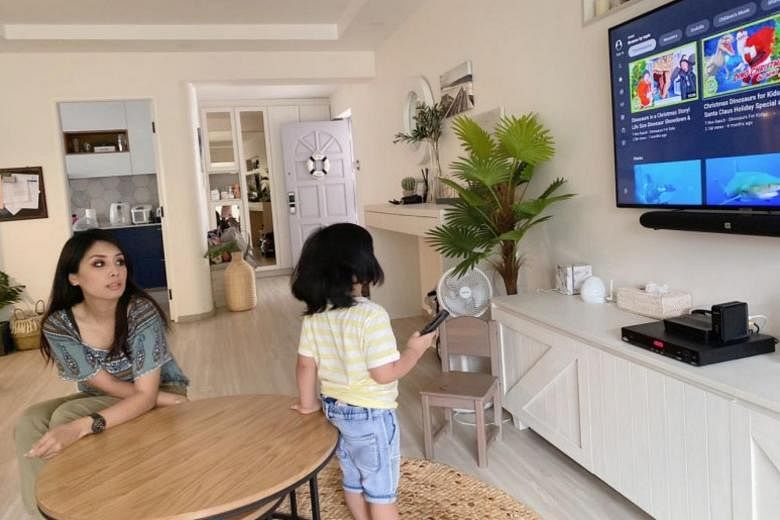SINGAPORE - At one point during the circuit breaker, four-year-old Shakeel Adly Mohamad Hidayat was watching eight hours of television a day.
When the circuit breaker restrictions started in early April, Shakeel's family of seven were busy adjusting to the upending of their household routines, which contributed to Shakeel doubling his usual daily screen allotment of four hours.
His mother, Ms Diah Mastura Roslan, was supervising the home-based learning (HBL) of her older children, especially for her twins Myreen and Mysha, both 11, who are taking their Primary School Leaving Examination (PSLE) this year.
The stay-home mother of five kids aged one to 13, who is a blogger and influencer, spent several hours a day doing product reviews and videos, in addition to breastfeeding her one-year-old daughter, Melisa.
"It was chaotic juggling so many things. When I was working, TV was the only way to keep Shakeel occupied. The TV was always on. Even when he was doing something else, his eyes would constantly be on the TV," says Ms Diah, 39, who blogs at etrangle.net.
Her 40-year-old husband, an essential worker in the oil industry, works outside the home.
Screen time exploded during the circuit breaker for adults and children alike. Many had to get used to working and studying online with HBL and online tuition classes.
With strict limits on going out during the circuit breaker, which lasted about two months, people of all ages used their devices to communicate with friends and family and to destress from anxieties evoked by the pandemic with video games and social media.
WRESTLING BACK CONTROL
But with Covid-19 entering its eighth month since the first case surfaced in Singapore in January, Ms Diah and other parents are trying to arrest the spike in their kids' screen time, which has spiralled out of control.
Screen-time data for children in Singapore during Covid-19 is hard to come by, but the challenges of managing the use of devices seem to be a common parental concern.
The Media Literacy Council recently held a webinar with SOOS OIO, a social enterprise that uses gaming to empower youth.
Parents raised concerns such as their children becoming "addicted" to YouTube; gaming until the wee hours; or playing computer games during HBL lessons.
Dr Jiow Hee Jhee, a programme director at Singapore Institute of Technology and a member of the Media Literacy Council, says: "It became clear to us that these were shared problems among many during the HBL period as children spent more time on their devices."
CONTENT MATTERS MORE THAN DURATION
But Dr Jiow's first assurance to alarmed parents is that the content which children are consuming online is more significant than how long they spend online.
The type of content matters in terms of shaping the child's cognitive growth, whereas the main issue with the quantity of screen time is that too much could affect Junior's physiological development.
For instance, too many hours spent online could affect a child's vision or posture, or take time away from physical exercise, he adds.
How much is too much? It depends on how old the child is.
As a guide, the authoritative American Academy of Pediatrics suggests no screen time (except for video calls) for children under age two; one hour a day of high-quality programmes for kids aged between two and five; and consistent limits on screen time for those over six.
Ms Carol Loi, founder of Village Consultancy, which provides digital literacy education, adds: "If children are mindlessly playing games on their own without consideration for school or sleep requirements, or just watching YouTube or TikTok videos for prolonged periods, their time could be better diverted."
Besides offline activities and outings for the whole family, which are now permitted after the lifting of some Covid-19 restrictions, Ms Loi suggests online alternatives for youngsters that "add value", such as social media posts that encourage and motivate others, making and maintaining good friendships online or educational apps.

BREAKING THE CYCLE
Ms Diah started introducing more diversions to help Shakeel break his excessive screen-time habit.
She realised that he was getting territorial about the TV remote control - even hiding it - and refusing to let family members switch channels away from his cartoons.
She determined to ride out his "one-minute tantrums" when she switched off the TV and urged him to play with educational toys and his favourite blocks instead. She also reinstated his pre-Covid-19 routines such as bedtime by 8.30pm.
By late April, he was down to a couple of hours watching TV a day.
"He was excited about choosing two books for bedtime stories - one for me, one for my husband. He responded well to the extra attention given to him," she says.
In other families, the resolve to reduce screen time is weakened by the recognition that increased gadget use has been a mixed blessing.
Ms Durga Devi Gopala Pillai, 34, noticed that her two daughters became more interested in YouTube after watching YouTube videos used in HBL lessons. At the same time, HBL helped her elder daughter, 10-year-old Vania Sankar, pick up digital skills like using e-mail and educational tools like Flipgrid, probably earlier than if Covid-19 never happened.
Still, the stay-at-home mother was concerned about her kids' prolonged screen time, even though there was little choice in the matter, with the stay-home restrictions.
They were spending five hours daily on HBL, which rose to eight hours after factoring in abacus and English tuition online twice a week. Additionally, Vania and her seven-year-old sister, Akshara, were watching TV about two hours a day.
Thankfully, the change in schedules enforced by the pandemic eventually helped Ms Durga and her husband, warehouse manager Sankar Subramanian, 45, cut down screen time for their daughters.
"When the school holidays were brought forward from June to May, there was not much HBL or holiday homework, so I took the opportunity to cut down on TV. We also engaged with them more," she says.
Besides trotting out Jenga and other games to lure the children from their screens, she used tips from a parenting workshop she had taken at Sinda (Singapore Indian Development Association) - TV was used as a reward, only after the kids had finished their work.
GOING WITH THE DIGITAL FLOW
In contrast, parents like Mr Leonard Ng were not bothered when screen time surged to seven hours a day for his sons during HBL.
The 38-year-old knew that their outdoor activities and playdates would resume after the circuit breaker.
Mr Ng, a counsellor and consultant at a community care agency, does not want Oliver, eight, and Kaleb, six, to lose out on digital skills in this digitalised age.
"I'm not too concerned about screen time. What's more important is that children understand that you have to do different things online, not just cartoons and games, but educational stuff as well," says Mr Ng, whose 37-year-old wife works in branding and sales.
Being a "gamer himself", he understands why kids feel upset when asked to abruptly stop an engrossing computer game.
He cautions his boys if he feels they are spending too long on a game. But they are allowed to negotiate for 10 minutes' extra time to finish a quest, for example.
He also curates their digital content, nixing YouTube videos with violent connotations and using parental controls and passwords. "They understand why (some things are not allowed)," he says.
He even plays games like Ark Mobile, which is centred on dinosaurs, with his sons.
"You can have different conversations, which are not necessarily about the game. We could talk about evolution and fossils or we could watch a show about palaeontology on National Geographic.
"It builds a bond with our kids."

HOW TO CUT DOWN ON SCREEN TIME
Mr Chong Ee Jay, a family life specialist at charity Focus on the Family Singapore, gives some tips:
EXPLAIN YOURSELF
Have conversations with your children about their screen time and online habits and explain the reason for your concern or why limits have to be set.
LISTEN BETTER
Listen to your children and consider their perspective. When they request more screen time, find out what they do online. By letting them know you are interested in what they do, you are in a better position to engage them.
COLLABORATE
Tensions often arise when you are trying to set limits. Avoid unilaterally imposing rules on children, as such an approach can cause them to feel disempowered or not trusted. Involving the kids in setting rules promotes accountability and facing consequences.
RESET EXPECTATIONS
Parents also need to recalibrate their own expectations as screens are integral to children's lives today. There is no easy solution to weaning them off excessive usage. Recalibrating your expectations may mean not fixating on how much time your children are spending online. Rather, pay more attention to the quality of the digital content they are consuming.
Parents can engage younger children in educational, interactive and age-appropriate videos and games. Encourage older children to create more meaningful content using certain apps and software.
WATCH YOUR OWN SCREEN TIME
By reducing or better managing their own screen time, parents are setting an example of self-discipline. By prioritising time with family, parents are affirming the value of each family member.
Adhere to family screen-time rules. Ask your family members to hold you accountable or use in-built tracking software in your phone such as Screen Time and Digital Wellbeing.
HAVE SCREEN-FREE AREAS
Create screen-free zones and times in your home, such as having devices off-limits one hour before bedtime and placing computers in full view in the living room.
Use Wi-Fi routers with parental controls or parental apps to manage screen time and content exposure (for example, FamilyTime and Kidslox).
Have more real-life interactions than screen time, such as enjoying a meal out together.


